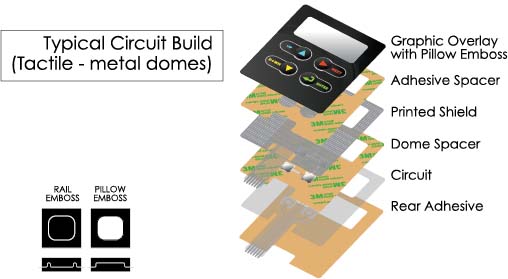A Comprehensive Guide to Membrane Switch Design and Manufacturing
A Comprehensive Guide to Membrane Switch Design and Manufacturing
Blog Article
Recognizing Membrane Layer Changes: The Trick to Durable and Reputable Controls
Membrane switches over represent a crucial element of modern interface design, blending capability with resilience in different applications. As we discover the complexities of membrane layer buttons, it ends up being clear that their duty in enhancing control systems is both extensive and intricate, increasing questions regarding just how ideal to leverage their abilities in future technologies.
What Are Membrane Layer Switches?
Membrane buttons are an innovative solution in the realm of customer interface innovation, integrating capability and layout seamlessly. These devices function as an interface in between customers and digital systems, incorporating numerous parts right into a small format. Generally constructed from flexible, thin layers of products, membrane layer switches are made to react to touch, allowing individuals to engage with machinery and electronic devices effectively.
The primary elements of a membrane layer switch consist of a published circuit layer, visuals overlay, and a spacer layer that protects against unplanned activation. The visuals overlay can be tailored to reflect brand name identification or individual preferences, boosting looks while making certain functionality. Membrane switches are commonly utilized in different applications, including clinical tools, consumer electronics, and commercial equipment, owing to their resilience and resistance to environmental factors such as dampness and dust.
One of the essential advantages of membrane layer switches is their capability to hold up against damage, making them ideal for high-traffic settings. Furthermore, they are lightweight and require very little area, enabling cutting-edge layouts in product growth. Generally, membrane changes stand for a useful and effective choice for contemporary digital interfaces, marrying technology with user-centric style principles.

Just How Membrane Layer Changes Work
The operation of membrane switches over depend upon a straightforward yet reliable system that equates user input into electronic signals. These buttons include several layers, usually including a graphic overlay, a spacer layer, and a circuit layer. When an individual presses the switch, the top layer flaws, enabling a conductive element in the circuit layer to make call with an equivalent conductive pad on the bottom of the visuals overlay. This call shuts the circuit and sends a digital signal to the gadget, showing that the button has been turned on.
The layout of membrane buttons can vary, yet they commonly incorporate domes or responsive components to offer responses to the individual, boosting the overall experience. The products used in membrane layer buttons, such as polyester or polycarbonate, add to their sturdiness and resistance to environmental factors, consisting of moisture and dust. Additionally, the published circuits are usually enveloped, which safeguards them from damage over time.

Benefits of Membrane Layer Switches
Among the main benefits of membrane layer switches is their convenience in style, allowing them to be customized to fulfill particular user requirements and aesthetic needs. This adaptability includes different sectors, where different forms, sizes, and shades can be employed to boost customer communication and aesthetic charm.
In addition, membrane buttons are known for their durability. Built from durable products, they are resistant to dirt, moisture, and physical wear, which dramatically extends their life expectancy compared to standard mechanical buttons. This sturdiness makes them specifically suitable for high-traffic atmospheres and applications calling for longevity.

In addition, membrane layer switches supply a structured profile, causing a thinner design that can be incorporated into different tools without adding mass. This feature not only boosts the aesthetic allure but likewise adds to an extra ergonomic product layout.

Applications of Membrane Buttons
User-friendly and flexible, membrane browse this site switches discover applications throughout a vast array of sectors, consisting of medical devices, consumer electronics, and industrial devices. In the clinical area, these buttons are essential to gadgets such as diagnostic devices, individual surveillance systems, and mixture pumps, where reliability and simplicity of cleansing are crucial. Their ability to stand up to rough environments and maintain capability makes them optimal for such applications.
In consumer electronic devices, membrane switches are used in products like microwaves, washing machines, and remote controls - membrane switch. Their smooth design allows for user-friendly interface, boosting the total individual experience while supplying resilience and resistance to use and tear
Industrial equipment also gains from membrane layer buttons, specifically in control panels for equipment and automation systems. These switches provide protection versus dirt and dampness, ensuring regular efficiency in difficult atmospheres. Moreover, their adjustable features allow suppliers to customize them to certain operational needs, boosting effectiveness and performance.
Selecting the Right Membrane Switch Over
When choosing a membrane layer button, it is crucial to think about different variables that affect performance and viability for particular applications. The primary considerations consist of environmental conditions, responsive feedback, resilience, and layout specifications.
First, examine the operating environment; switches revealed to moisture, chemicals, or extreme temperatures call for particular products to ensure durability and capability. Next, evaluate the requirement for responsive responses. Depending on individual communication, some applications might gain from a tactile reaction to validate activation, while others may favor a non-tactile design for aesthetic reasons.
Durability is another important variable; membrane switches ought to be created to hold up against frequent use, impacts, and abrasion. Guarantee the chosen button can sustain the anticipated lifecycle, particularly in high-usage scenarios.
Final Thought
In conclusion, membrane layer changes serve as essential components look at this now in the layout of long lasting and trustworthy control systems throughout different sectors. The adaptability of membrane switches allows for customized services that fulfill particular functional requirements, enhancing their relevance in modern technology.
Membrane changes stand for an essential element of modern-day interface layout, blending capability with resilience in numerous applications.Membrane buttons are an innovative service in the world of user interface innovation, combining performance and style seamlessly. Commonly constructed from versatile, thin layers of materials, membrane layer switches are created to react to touch, enabling users to engage with Read Full Report equipment and electronic tools properly.
The design of membrane layer switches can differ, yet they typically incorporate domes or tactile components to provide feedback to the customer, improving the total experience.In verdict, membrane switches over offer as important elements in the design of trusted and durable control systems across numerous sectors.
Report this page